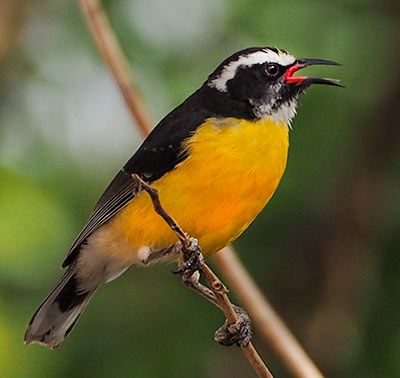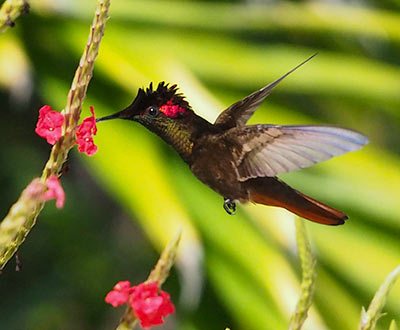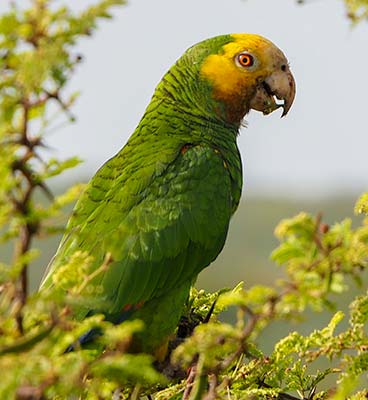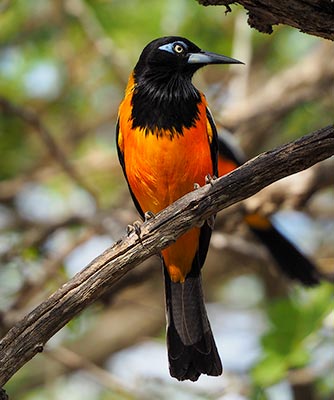Birdwatching is always a fun and educational.
Backyard birding provides a wonderful way to become familiar with many of Bonaire’s more visible species. Here’s a handy guide to many of the birds you can see right outside your accommodations or as you drive around Bonaire.
To enhance your enjoyment of Bonaire’s birds, consider touring with a local bird guide.
The Bananaquit.
The bananaquit, the “yellow bird” of the famous Calypso song, is also commonly called the “sugar thief” here on Bonaire. The bananaquit feeds upon nectar from flowers in your garden, and its slender, curved bill, has adapted well to nectar feeding. It can pierce a flower from the side, thus removing the nectar, but not pollinating the plant. Since it cannot hover (like hummingbirds), the bananaquit must perch while feeding.

The Bare-eyed Pigeon.
The bare-eyed pigeon is a species of bird in the family Columbidae. It is noticeable by the large ring around its eyes. It is found in northern Colombia, Venezuela, and the ABC islands, including Bonaire. Its natural habitats are subtropical or tropical dry forests and subtropical or tropical dry shrubland. Although very common on Bonaire, it can be a life bird for many Bonaire visitors who do not frequent South America.

Blue-tailed Emerald Hummingbird.
The Blue-tailed Emerald Hummingbird is Bonaire’s smaller of the two hummingbirds but is one of the most sought-after sightings as the males exhibit a rich iridescent green, with a bluish sheen to the face and breast, and deep blue tail. In poor lighting, the bird appears uniformly dark green. The female has gray underparts, and blackish cheeks bordered above by a whitish stripe. Found in any flowering gardens on Bonaire where they can collect nectar, but are often chased away by the larger Ruby-topaz Hummingbird.

The Brown-throated Parakeet.
Bonaire’s parakeet, the Brown-throated Parakeet, is locally known as a prikichi. Although this parakeet is found on all three ABC islands, the Bonaire parakeet is a special endemic subspecies (A. p. xanthogenia) found only here. What distinguishes it from parakeets from the other ABC islands is the rich yellow on its face.
The Brown-throated Parakeet can be found in nearly all areas of Bonaire with the exception of the Solar Salt Works in the south. It can be heard all day with its rather loud squawking and chatter.

The Carib Grackle.
The Carib Grackle is a highly gregarious species, foraging on the ground for insects, other invertebrates, or scraps, and it can be very protective of its territory.

The Eared Dove.
The eared dove is a New World dove. It is a resident breeder throughout South America from Colombia to southern Argentina and Chile, and on the offshore islands from the Grenadines southwards toward Bonaire.

The House Sparrow.
The House Sparrow is a European bird that has been introduced to all three ABC islands–Aruba, Bonaire, and Curacao. It can generally be found in areas of secondary low scrub growth, but can be also found visiting gardens.

The Pearly-eyed Thrasher.
One can easily see how this bird, Margarops fuscatus, received its common name, the Pearly-eyed Thrasher. It is generally found from the Bahamas in the north through the Grenadines in the south, but there is an isolated population here on Bonaire.
Pearly-eyed Thrashers can be somewhat secretive, but they can also be a bit garrulous. They can be found in many gardens around Bonaire and in the dry forest area of Bonaire’s northern section.

The Ruby-topaz Hummingbird.
The Ruby-topaz is a small hummingbird, also larger than Bonaire’s other hummingbird, the Blue-tailed Emerald. The male Ruby-Topaz is unmistakable with a golden throat, a ruby-red crown, and an orange tail with dark tips. The female is a bit more difficult to identify but look for pale gray underparts, white-tipped tail feathers, and dull grayish-green upperparts.
They are commonly found in flowering gardens all around Bonaire where they can collect nectar.

The Saffron Finch.
The Saffron Finch (Sicalis flaveola) is from the South American region. The male is bright yellow with an orange crown which distinguishes it from most other yellow finches. The females are more confusing and are usually just a slightly duller version of the male.

The Scaly-naped Pigeon.
The Scaly-naped Pigeon is one of several doves that can be found on Bonaire. It is a large slate grey pigeon (14–16 in), with maroon colored plumage around the neck, that can appear “scaly,” which is how it was named. There is a bare patch of skin that surrounds the bird’s red eyes; this patch tends to be reddish in males and more yellow in females. The legs and the base of the bill of the species are red, while the remainder of the bill is light-colored. The Scaly-naped Pigeon mostly feeds upon fruit and seeds of trees, so look for it in any backyard garden with berries, seeds, or fruits.

The Tropical Mockingbird.
The Tropical Mockingbird, or Chuchubi in Papiamentu, is probably the most commonly encountered bird, found in nearly any garden on Bonaire.
With a wide repertoire of calls and beautiful songs, it is usually the first bird heard right at sunrise, as it starts its day.

The Yellow-shouldered Amazon Parrot.
If you are staying in the northern section of Kralendijk or Hato or staying even further north, you will have an excellent opportunity to view Bonaire’s Yellow-shouldered Amazon Parrot, or lora, as it is known in Papiamentu. This parrot enjoys a protected status on Bonaire, and its numbers hover around 1000 individuals. A count of the parrots is done each year in January.
The birds can be quite raucous, calling loudly when first awakening at sunrise while they head out to feed. You’ll hear them chattering once again in the later afternoon.

The Venezuelan Troupial is an introduced species.
Many times found in pairs, their distinctive call carries and is easily identified.
Unfortunately, although the Venezuelan Troupial is beautifully colored, it frequently raids nests of other bird species. It is competing successfully against Bonaire’s similar species, the Yellow Oriole.

The Yellow Warbler
The Yellow Warbler is a New World warbler species. Yellow warblers are the most widespread species in the diverse genus Setophaga, breeding in almost the whole of North America, the Caribbean, and down to northern South America.








